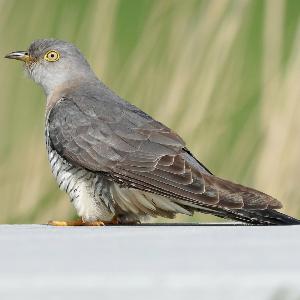Color variants in cuckoos: the advantages of rareness
24 Apr 2024
Rufous or gray: LMU evolutionary biologists show that the color variants of female cuckoos are based on ancient mutations.
24 Apr 2024
Rufous or gray: LMU evolutionary biologists show that the color variants of female cuckoos are based on ancient mutations.

Rufous variant of the female cuckoo. | © IMAGO / blickwinkel
Every cuckoo is an adopted child – raised by foster parents, into whose nest the cuckoo mother smuggled her egg. The cuckoo mother is aided in this subterfuge by her resemblance to a bird of prey. There are two variants of female cuckoos: a gray morph that looks like a sparrowhawk, and a rufous morph. Male cuckoos are always gray.
“With this mimicry, the bird imitates dangerous predators of the host birds, so that they keep their distance instead of attacking,” says Professor Jochen Wolf from LMU Munich. Together with researchers at CIBIO (Centro de Investigação em Biodiversidade e Recursos Genéticos, Portugal), the evolutionary biologist has investigated the genetic foundations of the variant coloring, which is limited to females and emerged over the long evolutionary arms race between host and cuckoo.
Hypotheses from behavioral research propose that the rarer color morph always has an advantage, because the host birds gradually get wise to the trick. If, for example, there are many sparrowhawk-like cuckoos or many sparrowhawks, the host birds learn over time to distinguish whether the bird in front of them is a sparrowhawk or a cuckoo. “Then the advantage of the rufous morph comes into play, as it is less common and has not been learned by the hosts,” says Wolf. Which variant the host birds learn depends on the abundance both of the cuckoos and of the birds of prey.

Gray variant of the female cuckoo. | © IMAGO / blickwinkel / AGAMI / F. Visscher
Only female cuckoos who have to get close to the host nests have these color morphs. “We would therefore expect these color variants – so-called polymorphisms – to be fixed somewhere in the female genome,” says Wolf. Whereas in humans it is males who carry a sex-specific chromosome, the Y chromosome, in birds it is females who have a sex chromosome, the W chromosome. With his team, Wolf has now demonstrated that the mutations for the color morphs are in fact located either on the W chromosome or in mitochondria, which are also passed down exclusively along the maternal line.
The researchers also showed that a sister species of the cuckoo, the Oriental cuckoo, possesses the same color morphs and mutations. “Consequently, the mutations already existed in a common ancestor and are therefore older than the speciation,” says Wolf. The evolutionary biologist sees this as a strong indicator that the rarer variant does actually always have an advantage: Where there are two variants, the better one normally wins out. But if the rarer of two variants always has an advantage, the system oscillates and settles into a certain frequency. “This causes the genetic variation to be maintained for a long time,” says Wolf. “Our results support the intriguing possibility that numerous other traits that are sex-specific but more difficult to investigate are genetically encoded on the matrilinear genome like the color polymorphism of the female cuckoo.”
J. Merondun et al.: Evolution and genetic architecture of sex-limited polymorphism in cuckoos. Science Advances 2024